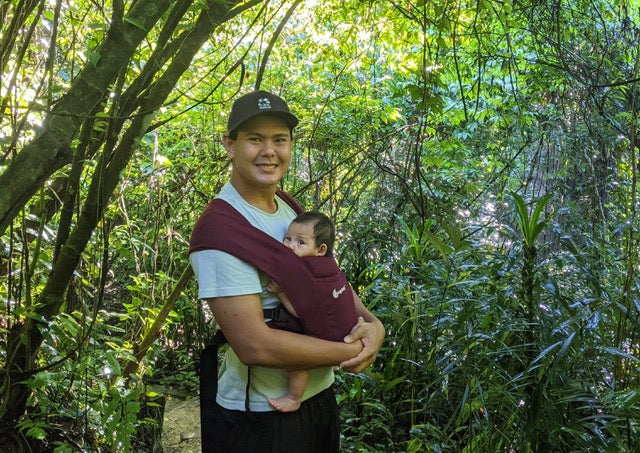What is babywearing?

Babywearing is exactly what it sounds like, it’s when you wear your baby! The practise of wearing babies has been done throughout the ages and across cultures. It’s a beautiful, natural way to create a deeper bond and give your baby the care they need by being close to them and still being up and about.
I started babywearing pretty early on, when my little one was only a few weeks old and I took her on walks with me. In the first few months, she would almost always fall asleep while I was wearing her. She also didn’t like being left lying down even if I was still in the same room, so sometimes the only way I could get anything done around the house was if I was wearing her. She’s ten months old now and to this day I still babywear when I’m out of the house with her as I find it easier than bringing a stroller. We enjoy being close to each other and she is so much calmer when she’s being carried by me. There are lots of pros to babywearing, some of which I highlight below.
The Benefits of Babywearing:

- Babywearing is especially beneficial in the first three months of an infant’s life. This is because being close to your body regulates their breathing and temperature, which they cannot do on their own yet.
- It encourages the wellbeing of both you and baby by releasing oxytocin, the love hormone, which is all kinds of feel good and promotes bonding.
- Being close to you means that baby feels safe and secure, which leads to less crying.
- It is good for their development because the sensation of movement will stimulate their senses and help them engage with you and with their surroundings. It also helps prevent flat head syndrome, which can occur when baby is lying down too much.
- It helps reduce reflux as baby is in an upright position.
- You will have your hands free and able to do things while with your baby, which is especially useful if you have a Velcro baby like mine!
- It’s convenient when going out as it’s less bulky than a stroller.
- It’s a form of exercise as you carry that extra weight while doing things.
- It keeps the germs away as people are less likely to reach out and touch your baby while you are babywearing.
The Different Styles of Babywearing:

- Cradle carry (for newborns)
- In front, facing you.
- In front, facing out.
- The hip carry.
- The back carry.
The Different Types of Carriers:

Wraps: A simple piece of long stretchy fabric that you can wrap around yourself.

Slings: Ring slings which are worn over one shoulder and feature rings to adjust length, or pouch slings which do not have rings and are simple pieces of looped fabric around one shoulder.

Framed backpacks: A solid carrier with a frame, used like a backpack for heavy duty wearing and activities such as hiking.

Soft carriers: Soft fabric in a structured carrier shape.

Babywearing shirts: A shirt that has a pouch for you to put your baby in, just like a kangaroo!

I started with a Moby wrap (pictured above) but found it difficult to keep redoing it every time I took her out then put her in again. Then I got a soft structured carrier, the Ergobaby Embrace, which was perfect for us while she was a newborn. I used this until she was about seven or eight months old when she became too wriggly and heavy. I needed more support, so I started using the Ergobaby Omni 360 which was gifted to me by a friend, and I love it. Both my husband and I use it; it’s easy to put on, gives us the support we need, and has some cool features to it.
Things To Consider When Buying A Carrier:

The carrier you get will depend on your needs and there are some things to consider before buying one:
- What positions you want to carry your baby in.
- What kind of fit you want from your carrier.
- What the age and weight limits are for the carriers. Not all are suitable for newborns, and not all will give you the support you need when baby gets older and heavier.
- What material you want for the climate you’re in.
Finally, always remember the TICKS for safe babywearing!
T – Tight, baby should be firm against you.
I – In view at all times, making sure you can always see baby’s face. Does not apply for back wearing position, obviously!
C – Close enough to kiss. You should ideally be able to look down and kiss your baby’s head.
K – Keep baby’s chin off their chest so as not to restrict breathing.
S – Support the back so that baby doesn’t slouch in a too loose position and compromise their breathing.
If you're a Boss Mama, do join our 24/7 Telegram Mommy Hotline on Telegram where we seek to support and empower mothers daily through love and knowledge sharing.

